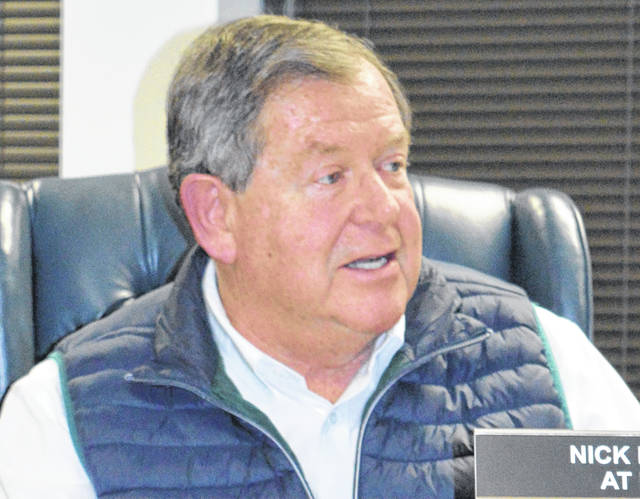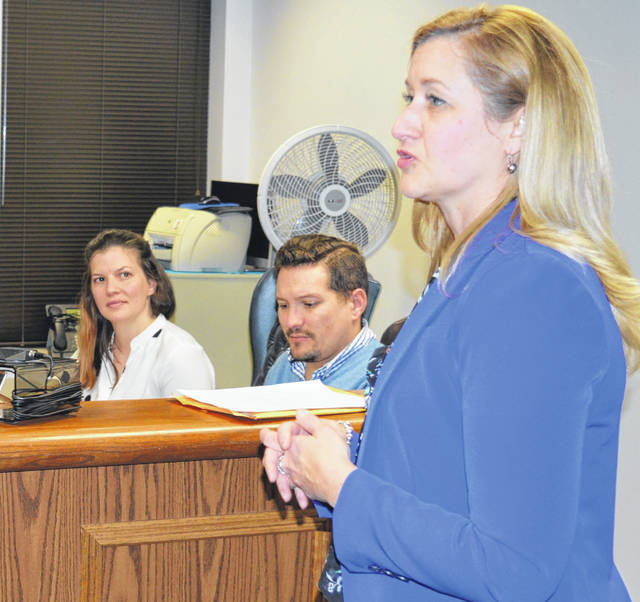

WILMINGTON — Partly to reassure residents that switching to a two-way stop at South and Sugartree Streets makes sense, a short-term test of the setup is recommended as plans develop for an intersections project.
Wilmington City Council voted Thursday night for the planning to continue on a project aimed at improving the downtown South Street (U.S. Route 68) intersections with Main, Locust and Sugartree Streets.
Councilman and City Services Committee Chair Nick Eveland told the full council the biggest question about the project on the minds of committee members and others is whether the existing traffic light at South South and Sugartree Streets should be eliminated, as proposed.
If the light is taken down, South Street traffic would not be required to stop, whereas Sugartree traffic would have to halt both ways at stop signs and wait for an opening in the South Street traffic.
Based on the traffic volume, accidents and the cross traffic, the Ohio Department of Transportation (ODOT) does not regard a traffic light to be warranted at the South and Sugartree intersection, according to Eveland.
With ODOT’s position on the issue perhaps relatively unknown by the general public, the committee is recommending a test program to make motorists more comfortable with the prospect, as well as to try out the two-way stop idea, Eveland said.
Testing the two-way stop arrangement could involve putting the traffic light on a flashing mode, and blacking out the existing pavement markings and putting down new lines that would indicate how the intersection would work, he said.
City Administrator Marian Miller reported the mayor has ordered a second traffic study be performed at the intersection to see whether the newly relocated TinCap business on Sugartree Street has changed the traffic numbers.
Another thing to consider, said Eveland, is what would happen to eastbound traffic on Sugartree Street if Main Street is closed for a special downtown event.
The newly elected councilman wondered aloud how that is going to work when there has to be an officer direct traffic at the intersection.
In early January, Wilmington Safety/Service Director Brian Shidaker said of the intersection, “We have six times the traffic going north and south as we do east and west. They’re recommending a two-way stop with bump-outs [curb extensions]. I know everybody is going to be concerned that when you stop, heading west on Sugartree, you can’t see on South Street because of the New Life Clinic. There will be construction improvements so that you will be able to see.”
Councilwoman and Public Works Committee Chair Kelsey Swindler reported during the meeting the city has received a $64,509 fluoridation grant from the Ohio Department of Health. Combining this grant with a $21,000 grant received in 2018, and the total Ohio Department of Health grant amount is about $85,000.
She expressed gratitude to the Ohio Department of Health for allowing the city to apply in multiple years for the funds. Swindler later said the city remains on track for having fluoridated water later this year.
Jennifer Ekey, the Clinton County Port Authority’s new economic development director, introduced herself at the session of city council. She said she wants to meet with council members individually for 60 minutes, and is very interested in their thoughts and opinions about the direction of the community, and what they see as their vision and mission.
At the end of the meeting, Eveland said he likes Ekey’s take on economic development, and agrees with her that residential housing stock is something that really needs to be looked at “as far as future directions are concerned.”
In looking ahead and trying to help supply employees for the industries in town that are growing, Eveland said Wilmingtonians need to figure out what can be done to increase and enhance the housing stock.
People who reside within the city pay the city’s income tax, support its schools, and attend and support its churches, said Eveland, who was Wilmington mayor during the 1980s and ’90s.
“If we’re going to work for housing development, which I think we need to, and encourage developers to put new housing in Wilmington, then we also need to work with them as best we can to get developers to risk their money on housing projects,” he continued.
Being supportive of housing development, said Eveland, involves the city gearing up to support the necessary water and sewer infrastructure that underpins housing growth.
The appointment of local attorney David Henry as Wilmington’s assistant director of law and as chief municipal prosecutor was confirmed Thursday.
He previously was a Clinton County assistant prosecutor, and has been law director for the City of Xenia and assistant law director for the City of Troy.
Mayor John Stanforth, in his council report, said he is very happy to announce the city’s insurance renewal involves only a 3.4 percent increase.
Reach Gary Huffenberger at 937-556-5768.



